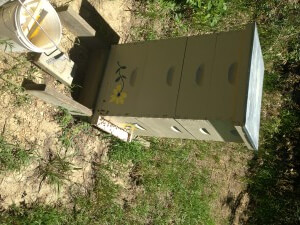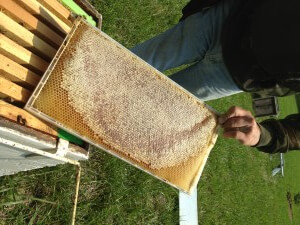We know our favorite bear was fond of “Hunny.” But how does one get the honey from the hive into the pot?  I’ve recently had several friends ask me that question. So, let’s take a trip to the extracting room to see the process. To further quote our favorite bear.
I’ve recently had several friends ask me that question. So, let’s take a trip to the extracting room to see the process. To further quote our favorite bear.
“A day without a friend is like a honeypot without a single drop of honey left inside.”
See you there!
 A touch of fall is in the air and most beekeepers will have pulled off the last of their honey supers for the year. The queen’s frenzied egg laying activity is slowing which signals the workers to put up enough food supplies to survive the winter.
A touch of fall is in the air and most beekeepers will have pulled off the last of their honey supers for the year. The queen’s frenzied egg laying activity is slowing which signals the workers to put up enough food supplies to survive the winter.
Supers are shallow boxes that hold the frames in which the bees build out comb to store honey. They come in several sizes, mine are 6 5/8 inches deep. Honey supers are generally less deep than hive bodies as the deeper boxes serve a dual purpose as both brood chamber and food storage, in order to feed all those hungry offspring. Supers are primarily used for honey storage as most beekeepers restrict the queen from laying eggs in the shallow frames through the use of a queen excluder. A capped frame of honey can become quite heavy and a full super can weigh between 30-50 pounds. Earlier this summer, my first super contained 31 pounds of extracted honey.
 Remember, in order to extract honey, the moisture content must be between 14-18 percent, otherwise the honey would ferment. The bees have their own internal sensors and know when best to cap the honey to preserve it. But the beekeeper checks the moisture content with the use of a refractometer prior to extraction. One of my super’s frames, though not completely capped, contained a lot of honey. The initial moisture content was 21%. We set the super in a de-humified closet for a couple of days and the moisture content prior to extraction was down below 16.
Remember, in order to extract honey, the moisture content must be between 14-18 percent, otherwise the honey would ferment. The bees have their own internal sensors and know when best to cap the honey to preserve it. But the beekeeper checks the moisture content with the use of a refractometer prior to extraction. One of my super’s frames, though not completely capped, contained a lot of honey. The initial moisture content was 21%. We set the super in a de-humified closet for a couple of days and the moisture content prior to extraction was down below 16.
 The honey frames are de-capped using a heated electric knife and a capping scratcher. I was fortunate enough to be allowed the use of the extraction room at Hillside Honey. Extraction equipment can be costly for the new beekeeper so my thanks to John and Gina Rockrohr for the generous use of their time and equipment.
The honey frames are de-capped using a heated electric knife and a capping scratcher. I was fortunate enough to be allowed the use of the extraction room at Hillside Honey. Extraction equipment can be costly for the new beekeeper so my thanks to John and Gina Rockrohr for the generous use of their time and equipment.
 The wax cappings are collected into a capping tanks to be used in processing beeswax for resale. Some honey remains in the capping tank as well and will be filtered out for re-use. The process for obtaining clean pure beeswax is tedious and involves multiple filtering before it can be sold in a melted form.
The wax cappings are collected into a capping tanks to be used in processing beeswax for resale. Some honey remains in the capping tank as well and will be filtered out for re-use. The process for obtaining clean pure beeswax is tedious and involves multiple filtering before it can be sold in a melted form.
 Once the frames are de-capped, we head to the extracting tank. Extracting tanks are made with high-quality stainless steel for ease in cleaning and sanitation. I’m using a manual two frame extractor in which the de-capped frames are placed opposite one another in a steel basket. The hand cranks spins the basket within the stainless steel drum and centrifugal force does the rest. The frames are then reversed and the process is repeated to extract both sides.
Once the frames are de-capped, we head to the extracting tank. Extracting tanks are made with high-quality stainless steel for ease in cleaning and sanitation. I’m using a manual two frame extractor in which the de-capped frames are placed opposite one another in a steel basket. The hand cranks spins the basket within the stainless steel drum and centrifugal force does the rest. The frames are then reversed and the process is repeated to extract both sides.
 Once enough honey collects in the bottom of the drum, it flows through the opening and passes through two stainless steel mesh filters before dripping into the collection bucket.
Once enough honey collects in the bottom of the drum, it flows through the opening and passes through two stainless steel mesh filters before dripping into the collection bucket.
 The collection bucket is sealed and ready for bottling. Raw honey is not heated or processed only filtered to remove the wax and any stray bee parts(just kidding!) It retains all of the natural goodness and nutrient quality the bees worked so hard to instill.
The collection bucket is sealed and ready for bottling. Raw honey is not heated or processed only filtered to remove the wax and any stray bee parts(just kidding!) It retains all of the natural goodness and nutrient quality the bees worked so hard to instill.
 The process is fairly low-tech but labor intensive at the backyard beekeeper’s level. Commercial operations invest heavily in extracting equipment but a small two frame extraction kit can be purchased for under a thousand dollars. Still a significant investment for a hobby considering the costs of the beehives, frames and of course the bees themselves.
The process is fairly low-tech but labor intensive at the backyard beekeeper’s level. Commercial operations invest heavily in extracting equipment but a small two frame extraction kit can be purchased for under a thousand dollars. Still a significant investment for a hobby considering the costs of the beehives, frames and of course the bees themselves.
But, I think you will agree, the finished product is well worth it!